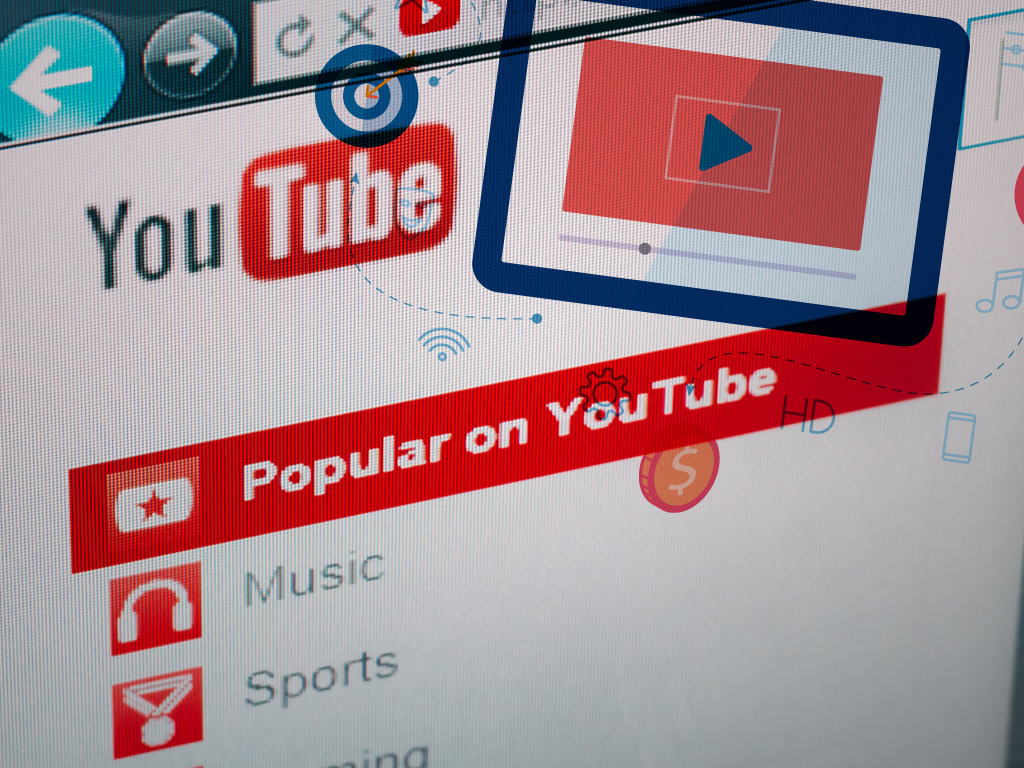The way things were…
I started uploading videos to YouTube a decade ago. Back in August 2006, we only had a couple of metrics for measuring our success. One was views, which counted the number of times that our video was watched.
The other was ratings, which showed the number of stars that a small percentage of viewers had given our video. Five stars meant they loved it; one star meant they loathed it.
In September 2009, YouTube replaced the five-star rating system. Why? Well, as the chart below illustrates, the overwhelming majority of videos on YouTube had a stellar five-star rating, while only a few viewers were moved to rate videos when they didn’t like them.

In other words, people either liked the video they’d just watched or they couldn’t be bothered to rate it. That made the five-star rating system pretty useless. And shortly after that, YouTube replaced it with the thumbs up, thumbs down ratings that Facebook had made popular.
And the way things are now….
Today, it’s time to replace the view metric.
Why? Because it has also become pretty useless. In fact, there are the three key reasons why video analytics needs to fundamentally change… again.
1. A “view” is not a view.
We’re now living in a multi-platform video world where a “view”, is not a view. YouTube says you pay for a “view” when a viewer watches 30 seconds of your video – or the duration if it’s shorter than 30 seconds – or engages with your video, whichever comes first.
On the other hand, Facebook says you pay for a “view” when a video is displayed in a user’s news feed for 3 seconds or more, even if the person doesn’t actually click on the video to watch with the sound turned on.
So, without a standardized definition of “view,” comparing the number views that your YouTube videos have with the number of views that your Facebook videos have is like comparing oranges and kumquats.
2. A view has no quantifiable value.
It’s time to admit that no one really knows what a view is actually worth. How many views do you need to increase brand awareness? How many views does a video have to get to have a direct impact on consumer perceptions and behaviors?
So, if a view isn’t a metric that matters, then why would any video marketer want to continue using it as a key performance indicator (KPI)? That’s not a KPI that will earn you a promotion or cost-justify a bigger budget.
3. As things stand, it’s impossible to budget based on view.
Third, if no one knows what a view is actually worth, then what is a good average cost-per-view (CPV)? Well, it’s probably going to be as low as possible, which isn’t one of the healthiest trends in the digital video marketing business.
This is bad for the platforms like YouTube and Facebook, which are selling video advertising. It’s especially bad for the YouTube content creators who are trying to monetize their videos with CPV advertising. And low-cost CPVs are not even particularly useful replacement metrics for the ad agencies that are still using gross rating points (GRPs) to measure their TV campaigns – especially with more and more of their clients are asking unanswerable questions like, “How many GRPs do I need to sell a car?”
So, what are the alternatives? Fortunately, there are now some good contenders to replace views as a metric.
Three alternative metrics to measure video marketing success
1. Watch time
First, video marketers should replace “views” with “watch time.” Why?
Well, about a year ago, the Google Agency Blog published some research which found that there is a consistent relationship between how long a video ad is viewable and increases in brand awareness and consideration. The longer a user views your ad, the higher the lift in these two important brand metrics.

Watch time is also a metric that matters for the two leading video platforms.
In October 2012, YouTube added “estimated minutes watched” to the “views” report in YouTube Analytics. A day later, the video sharing platform started adjusting the algorithm for the YouTube search results, benefitting engaging videos that kept viewers watching.
In June 2014, Facebook announced that it was adding how long someone watched a video to its ranking factors, which had previously included likes, comments, and shares. And in February 2016, Facebook added new metrics to its reports that let advertisers see the percentage of people who have viewed their videos with sound in Page Insights and Ad Insights, too.
2. ‘Brand Lift’
Second, video marketers should replace their assumptions about the putative value of video “views” with actual measures of “brand lift” or the rapid results of “brand polling.” How?
In February 2013, Google introduced its Brand Lift solution. It initially measured measure the actual impact of a YouTube ad campaign on brand awareness, ad recall and brand interest. Today, it also measures the impact of YouTube ads on consideration, favorability, and purchase intent.
How does Google’s Brand Lift work?
Google’s Brand Lift solution measures the above in two different ways:
To measure brand awareness, ad recall, consideration, favorability, and purchase intent, Google isolates a randomized control group that is not shown your YouTube ad, and an exposed group that does see your ad. About a day after seeing (or not seeing) your ad, Google Consumer Surveys delivers a survey to both groups. Since the only effective difference between the two groups is whether they saw your ad, Google can accurately determine the lift attributed to your campaign.
Google’s Brand Lift solution also measures the impact your YouTube ad campaign has on creating interest in your brand by using organic searches on both Google.com, the world’s largest search engine, and YouTube.com, the world’s second largest search engine. Similar to surveys, Google randomly picks a group that saw your ad and a control group that didn’t see your ad. Google then compares the organic search behavior of both groups, looking at how often they search for keywords related to your brand or campaign. The difference in searches can be attributed to your campaign.
After analyzing around 50 campaigns from Fortune 100 brands and category leaders running on Google Preferred, which includes some of YouTube’s most popular channels, Google found that:
- 94% of the campaigns drove a significant lift – an average of 80% – in ad recall.
- The analysis also found that 65% of Google Preferred ads saw an increase in brand awareness, with an average lift of 17%. This is particularly impressive considering that the brands in the study were already well-known.
Here’s a video that explains how Google’s Brand Lift solution works. It also mentions how Mondelēz International used Brand Lift to measure the marketing effectiveness of its Trident Unlimited launch in Brazil, and Nissan Canada used Brand Lift to measure the effectiveness of TrueView ads for its Micra model.
How does Facebook’s Brand Polling work?
Facebook and Instagram also offer brand polling solutions that enable advertisers to measure brand awareness and ad recall. Just like Google, Facebook randomly puts part of your target audience into a control group that isn’t able to see your ads. The poll is then served to the control group and a test group with identical characteristics. The lift between the control and test groups accurately shows the impact of Facebook and Instagram advertising.

3. Cost-per-acquisition (CPA)
Thirdly, advertisers should move beyond optimizing their video campaigns to get the lowest CPV and start using cost-per-acquisition (CPA) bidding for video ads instead.
For a YouTube ad campaign, you can use a CPA bid strategy to tell AdWords the amount you’re willing to pay for a conversion. AdWords will then automatically sets your bids to give you as many conversions as possible at your targeted cost-per-acquisition.
This strategy can help you reach customers who are likely to take an action, such as making a purchase (for an ecommerce site), completing a game level (for a mobile gaming app), or submitting a contact information form (for a marketing or lead generation site).
Targeted CPA bidding focuses on maximizing conversions for your video ads, rather than views, as in CPV bidding. You still pay per view, but AdWords automatically sets your bids to help you get more conversions.
Case Study: Gillette BODY
For example, Gillette targeted a rapidly expanding audience of body-grooming men to create buzz around its latest product, Gillette BODY. With a campaign anchored by a YouTube ad entitled “100 Years of Hair” the brand got more than 14 million views (if you still want to count those!).
https://www.youtube.com/watch?v=h16y4m2TJsgThe stats were far more important:
- 84% of viewers watched at least 85% of the ad.
- Gillette searches grew by 211% and clicks grew by 111% (biggest increase ever for the brand)
- And the campaign delivered more than 500,000 clicks-to-buy Gillette BODY, surpassing sales expectations by up to four times across seven markets.
Facebook also helps advertisers determine exactly how their video ads impact their bottom line by offering conversion lift measurement capabilities. Building on existing Facebook measurement offerings, conversion lift allows advertisers to accurately determine the additional business driven by Facebook ads and make future marketing decisions based on this information.
Case Study: Open Colleges, Australia

For example, Open Colleges, Australia’s leading online learning provider, used a conversion lift study to measure the full impact of its Facebook campaigns. Results from the study revealed:
- a 95% lift in conversion rate for website inquiries
- a 12% lift in offline enrollments.
- cost per acquisition was also 23% lower than what Open Colleges’ last click model had indicated.
Summary: What does this mean for video analytics?
In short, the video analytics that you’ve been using for the past decade need to fundamentally change if you want to measure what matters today. Imagine being able to go beyond traditional metrics like views to measure your video ad campaign’s impact on brand awareness and consideration.
Imagine being able to answer tough questions from skeptical executives who want to know:
- Do people truthfully recall watching our video ad?
- Are our target consumers really more aware of our brand after viewing our video ad?
- Did our video ad actually move people to consider our brand or product?
- Are consumers even more favorably aligned with our brand’s message or identity after viewing our ad?
- Are consumers truly intending to purchase our product after seeing our ad?
- Are people genuinely more interested in our brand or product?
- Did our ad honestly increase organic search activity for our brand or product?
And finally, just imagine the impact on your career as well as your company’s success if you begin to focus your video ad campaigns on the highest value conversions with the lowest purchase amount.
That’s a powerful reason to unlearn what you have learned back in 2006. And, that’s why video analytics needs to fundamentally change today, not 10 years from now.
What are your thoughts on how we should be measuring video marketing success?


